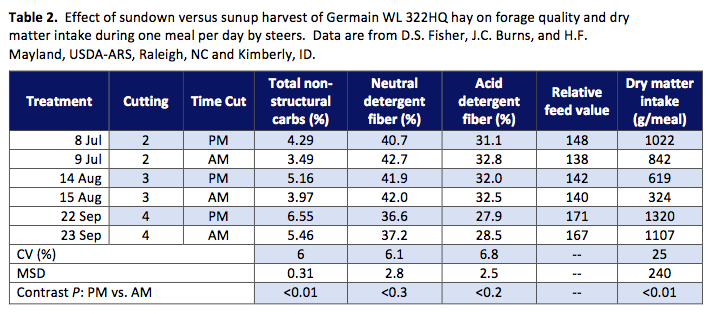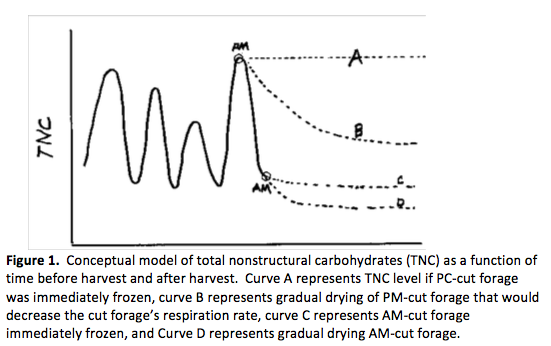 United States Department of Agriculture
United States Department of Agriculture
Agricultural Research Service
Northwest Irrigation & Soils Research Laboratory
Revised March 1999
Diurnal Cycling in Forage Quality
by H.F. (Hank) Mayland and Glenn E. Shewmaker*
Sundown (PM) Versus Sunup (AM) Cutting of Forages
On 5th August 1996, Mayland was interpreting soluble-carbohydrate data measured in the ‘Grazing Preference Study’ noted above and reconciling them with published values. A check of literature available at the lab and a call to J.C. Burns, Raleigh, NC showed a general increase in sugars during the daylight hours and a suggested diurnal cycling of sugars in the plant. No information was found then about effects of diurnal cycling of sugars on grazing behavior or animal choices of variously cut hays. An experimental protocol was developed to evaluate animal response to sundown (PM) versus sunup (AM) harvested hay. Vegetatively growing HiMag tall fescue was harvested on a PM/AM schedule 20-22nd Aug. and 20-21st Sept. 1996 at Kimberly, Idaho. Hay was field cured, baled, and trucked to Raleigh, NC where it was fed in a preference trial. Results from that first study, summarized below, were very exciting and led to other studies evaluating the potential application of this technology. As information becomes available it will be presented in technical meetings and publications, as news releases and by word of mouth. *It is very important that the PM-harvest occur the night before the AM-harvest so that both have the same conditions for sugar accumulation. *
PM/AM – Cut Tall Fescue Grass
Fisher, D.S., H.F. Mayland, and J.C. Burns. 1999. Variation in Ruminants’ Preference for Tall Fescue Hays Cut Either at Sundown or at Sunup. J. Anim. Sci. 77:762-768. Cattle, Sheep, and Goats all showed a strong preference for the PM-cut hay, sometimes eating 50% more of the PM hay. This preference, indicated by dry matter intake, was associated with greater total nonstructural carbohydrate (TNC) concentrations. The TNC’s accumulated during the day, diluting acid detergent fiber (ADF), and neutral detergent fiber (NDF).

PM/AM – Cut Alfalfa
 Fisher, D.S., H.F. Mayland, and J.C. Burns. 1998. Variation in ruminant preference for alfalfa hay cut either at sundown or sunup. J. Anim. Sci. 1998, 76 (Suppl. 1, Abstract # 753). Technical manuscript being prepared. A 2nd technical manuscript is being prepared on long term dry matter intake and in vivo digestibility by steers.
Fisher, D.S., H.F. Mayland, and J.C. Burns. 1998. Variation in ruminant preference for alfalfa hay cut either at sundown or sunup. J. Anim. Sci. 1998, 76 (Suppl. 1, Abstract # 753). Technical manuscript being prepared. A 2nd technical manuscript is being prepared on long term dry matter intake and in vivo digestibility by steers.
Like with the tall fescue, alfalfa was grown in 1997 near Kimberly, Idaho swathed on PM/AM schedule, baled, and shipped to Raleigh, NC where is was fed in ‘preference’ study to cattle, sheep, and goats. Hays were offered alone as meals to each animal during an adaptation phase prior to the experimental phase. In the experimental phase, each possible pair of hays (15 pairs) was presented to sheep and goats for approximately 2.5 h and to cattle for approximately 0.5 h Presentation of the pairs was randomized. In all three harvests in the three experiments, preference for PM hays was greater than for AM hays (p<.01). Shifting the mowing of alfalfa hay from morning to late afternoon was effective in increasing forage preference in these three ruminant species.

PM/AM – Cut C-4 Switchgrass (Panicum virgatum L.)
Fisher, D.S., J.C. Burns, and H.F. Mayland. 1999. Diurnal Harvest Timing and Ruminant Preference for Switchgrass Hay. For presentation Am. Soc. Agron., annual meeting Oct – 5 Nov. 1999, Salt Lake City. Sheep preferred but goat varied in preference for PM vs AM-harvested switchgrass hays. This response was attributed to greater variability among the harvest treatments. This may be a climatic or genetic response.
Production Response Keyed to Diurnal Cycling of Forage Quality
Dairy Cows will eat about 8% more of a total mixed ration (TMR) containing 40% afternoon-cut alfalfa hay than one containing morning-cut alfalfa hay and will produce about 8% more milk. Adjusting schedules to cut hay in afternoon and early evening can increase feed value of hay by 15%. Kim D. 1995. Effect of plant maturity, cutting, growth stage, and harvesting time on forage quality. Ph.D. Diss. USU, Logan, UT.
Green-chopped alfalfa cut in the afternoon will have more feed value and is relished more by cows than if cut in the morning (Mayland, observation).
When making silage from alfalfa or clover hay, one can enhance the fermentation process by cutting the hay in the afternoon compared to cutting in the morning.
Owens, V.N., et al. 1999. Protein degradation and fermentation characteristics of red clover and alfalfa silage harvested with varying levels of total nonstructural carbohydrates. Crop Sci. 39:1873-1880.
Dairy cows foraging pastures under 24-h strip grazing management produced 8% more milk when fence was moved after the afternoon milking (4pm) vs after early morning milking (6am). Orr, R.J., et al. 1998. Matching grass supply to grazing patterns for dairy cows under strip-grazing management. Report of Instit. Grassld. Leviron. Res., North Wyke, Okehampton, Devon, EX20 2SB, UK. Personal communication.
Increased sugars in afternoon forage may explain increased bite counts in afternoon vs. morning grazing.
Documenting Diurnal Cycling in Forage Quality
Daily cycling of forage quality, especially as it affects animal eating behavior and economic value, has not been researched prior to 1995. Plant physiological data on sugar accumulations rarely included entire above ground plant material grown in full canopy in the field. Unequivocal evidence of animal preference for sundown- versus sunup-harvested forage has led us to investigate and document gains and losses of soluble sugars at periodic intervals on 12 or 24-h basis.

Shewmaker, G.E., H.F. Mayland, C.A. Roberts, P.A. Harrison, and E.A. Sleper. 1999. Carbohydrate Accumulation Rates in Tall Fescue. In preparation. Samples were taken at 2-h intervals, from sunup to sundown, from eight tall fescue cultivars, and four times during the season. Over the time period of 2-h post-sunup until 2-h pre-sundown, total nonstructural carbohydrates (TNC) increased linearly from 222, 212, 127, and 98 g TNC/kg DM in May, July, Aug, and Sept. respectively at rates of 3.2, 2.4, 3.0, and 4.4 g TNC/kg DM / hr. Tall fescue forage samples taken for TNC determination should be taken within a 1-h period for values to be within 5% of mean, otherwise sampling times should be blocked. The linear portion of TNC values were plotted by cultivar against time. The TNC slopes were not different among cultivars. Intercepts were different for cultivars and were proportional to animal preference. Kenhy had the highest TNC intercept and highest cattle preference while Mozark had the lowest intercept and preference.
Shewmaker, G.E., H.F. Mayland, J.C. Burns, and D.S. Fisher. 1999. Alfalfa quality and Implications for Testing. Proc. Western Crop Sci. Soc. Annual meeting Powell, WY, 28 – 30 June 1999. Forage samples were taken at 3-h intervals, around the clock for 3 to 5 days prior to swathing of each of 4 cuts of alfalfa. Diurnal variation of carbohydrates (TNC) was detected. In May, the TNC increased linearly from about 9am to 9pm at 2.9 g TNC/kg DM/h (coef determination = 0.90). Fresh alfalfa forage samples taken for
TNC determination should be taken within a 1-h period for values to be within 5% of mean or sampling times should be blocked.
Scientists Working on Various Phases of Carbohydrate Cycling & Forage Quality:
Mayland, H.F. (Hank) USDA-ARS, Kimberly, ID mayland@kimberly.ars.pn.usbr.gov
Burns, Joe C., USDA-ARS, Raleigh, NC jburns@cropserv1.cropsci.ncsu.edu
Burritt, Beth, USU, Logan, UT bethb@cc.usu.edu
Chatterton, N. Jerry, USDA-ARS, Logan, UT njchatt@cc.usu.edu
Crawford, Richard, U.MO, Mount Vernon, MO crawford@ext.missouri.edu
Dove, Hugh, CSIRO, Canberra, ACT 2101, Australia hugh.dove@pi.csiro.au
Fisher, Dwight S. USDA-ARS, Watkinsville, GA Dwight_Fisher@scientist.com
Flath, Robert USDA-ARS, Albany, CA, retired raflath@ix.netcom.com
Harrison, Phil USDA-ARS, Logan, UT
Henry, David, CSIRO, Wembly, WA, Australia d.henry@ccmar.csiro.au
Hussein, H. U., UNV, Reno, NV hhussein@agnt1.ag.unr.edu
Kim, Dayoon, Systemic Formulas, Ogden, UT dkim@systemicformulas.com
Lee, Julien, CRI, Grasslands, Palmerston N., NZ leej@agresearch.cri.nz
MacAdam, Jennifer, USU, Logan, UT jenmac@cc.usu.edu
Martin, Scott Univ. GA, Athens, GA scottm@arches.uga.edu
McCaughey, W. Paul Brandon, Manitoba pmccaughey@em.agr.ca
Owens, Vance, SDSU, Brookings, SD owensv@www.ces.sdstate.edu
Provenza, Fred, USU, Logan, UT stan@cc.usu.edu
Roberts, Craig, Univ. Mo, Columbia, MO roberts@psu.missouri.edu
Roitman, Jim, USDA-ARS, Albany, CA jnr@pw.usda.gov
Rook, Andrew, Inst. Grassland & Environmental Res. Okehampton, Devon, UK EX20 2SD aj.rook@bbsrc.ac.uk
Shewmaker, Glenn, Univ. ID, Twin Falls, ID gshew@uidaho.edu
Sleper, Dave, Univ. MO, Columbia, MO sleperd@missouri.edu
Villalba, Juan, USU, Logan, UT villalba@cc.usu.edu
![]()



